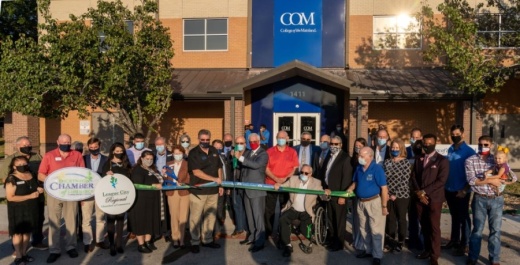Leaders from two Bay Area technical schools discussed the value of a community college educational experience amid COVID-19 during a Nov. 16 State of Higher Education luncheon.
Teri Crawford, San Jacinto College’s vice chancellor of marketing, public relations and government affairs, and College of the Mainland President Warren Nichols spoke at the luncheon, which was sponsored by the League City Regional Chamber of Commerce. The two leaders detailed how the educational experience at their respective colleges has been adapted to meet the challenges of the pandemic.
“It’s educators like these that are helping to ensure students are ... completing what they start,” said Amanda Fenwick, San Jacinto College’s vice president of marketing and public relations, who emceed the luncheon event. “They're fighting these COVID-19 challenges every day and working through them to make sure that when our campuses do open, they are safe.”
San Jacinto College is the state’s eighth-largest community college, Crawford said, with five campuses and the EDGE Center at Ellington Airport’s Houston Spaceport. About 7 in every 10 SanJac students are enrolled in academic transfer programs, setting them up to continue their education at a four-year institution, where the remaining 30% of students are enrolled in workforce training programs.
Prepandemic, the college saw 45,000 students taking credit and noncredit courses annually. About 30,000 students were enrolled during the fall 2020 semester, Crawford said, with the enrollment drop attributed to COVID-19.
Nearly half of San Jacinto College students are first-generation college students, Crawford said, and many in the registered nurse-to-Bachelor of Science in Nursing nursing program are working hospital shifts. The college keeps these and other challenges or constraints in mind when selecting course instruction times, allowing students to continue their education while in the workforce or caring for family members, Crawford said.
In terms of pandemic relief, the college has adapted day-to-day operations through efforts such as on-campus food markets for students and employees and implementing a contactless dropbox system for transcripts and other official documents. General commencement activities and pinning ceremonies for nursing students have also been altered; the former has been and will be taking place virtually, while the latter was revamped into a drive-thru event.
College of the Mainland did not see enrollment decreases as stark as those at San Jacinto College. However, enrollment was down about 5% year over year for the fall semester, and that will likely be the case in the spring, Nichols said.
The college purchased additional laptops to issue to students and faculty for free as the community adapted to virtual learning, Nichols said. The spring semester will involve “all possible instruction” being taught online, he added.
COM will welcome students and staff to several new buildings by the end of 2021, including its League City facility, which was unveiled Nov. 12. The facility features more than 27,570 square feet of remodeled learning space and will be primarily used to help accommodate the more than 400 dual-credit students attending Clear Creek ISD high schools. General education classes and a new 18-month accelerated Associate of Arts program will find homes in the new facility.
Other new buildings include the science, technology, engineering, mathematics and arts building, which will be the largest building in Texas City once completed in the spring, Nichols said. Construction is on time and under budget, he said, and the college will get access to the building in February.
COM officials hope to have students and staff in the new STEAM building by April 2021, around the same time a new administrative building will be opening, Nichols said. Construction also begins in January on an industrial careers building, which will house many of the college’s workforce programs, he said.
While both college leaders agreed the pandemic has created uncertain conditions for its students, Nichols said junior colleges can prove to be invaluable for students starting their journey in higher education—despite the misconception that a community college education is inferior to the experience gleaned at a four-year university.
“I am a community college, first-gen student myself,” Nichols said Nov. 16. “If it had not been for the local community college ... gosh knows what would have happened. I am unabashedly proud of being a community college graduate.”





